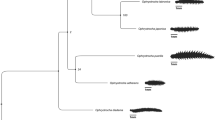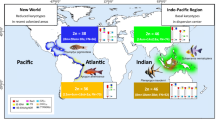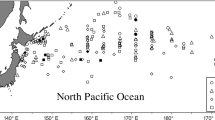Abstract
Adult somatic nuclear DNA contents are reported for eleven cyclopoid species (Megacyclops latipes, Mesocyclops edax, M. longisetus, M. ruttneri, M. leuckarti, M. woutersi, Macrocyclops albidus, Cyclops strenuus, Acanthocyclops robustus, Diothona oculata, Thermocyclops crassus) and for the harpacticoid Tigriopus californicus and range from 0.50 to 4.1 pg DNA per nucleus. These diploid genome sizes are consistent with previously published values for four Cyclops species (0.28–1.8 pg DNA per nucleus), but are strikingly smaller than those reported for marine calanoids (4.32–24.92 pg DNA per nucleus). We discuss three explanations, none of them exclusive of another, to account for the smaller size and range of cyclopoid genome sizes relative to calanoid genome sizes: (1) higher prevalence of chromatin diminution in the Cyclopoida, (2) phylogenetic structure or older age of the Calanoida relative to Cyclopoida and (3) nucleotypic selection that may influence life history variation and fitness. Measurements of genome size were made on Feulgen stained, somatic cell nuclei, using scanning microdensitometry which is well suited to the sparse and heterogeneous populations of copepod nuclei. The importance of measuring large numbers of nuclei per specimen, possible sources of variation associated with cytophotometric measurements, and appropriate use of internal reference standards and stoichiometry of the Feulgen stained nuclei are discussed.
Similar content being viewed by others
References
Aeby, P., A. Spicher, Y. de Chastonay, F. Müller & H. Tobler, 1986. Structure and genomic organization of proretrovirus-like elements partially eliminated from the somatic genome of Ascaris lumbricoides. EMBO J. 5: 3353–3360.
Akif'ev, A. P., 1974. DNA which keeps silent and its role in evolution. Priroda (USSR) 9; 49–54. (in Russian)
Alvarez-Fuster, A. C. Juan & E. Petitpierre, 1991. Genome size in Tribolium flour-beetles: inter-and intra-specific variation. Gen. Res. Camb. 58: 1–5.
Amma, K., 1911. Ñber die Differenzierung der Keimbahnzellen bei den Copepoden. Arch. Zellforsch. 6: 497–576.
Beaton, M. J. & P. D. N. Hebert, 1997. The cellular basis of divergent head morphologies in Daphnia. Limnol. Oceanogr. 42: 346–356.
Beaton, M. J. & P. D. N. Hebert, 1989. Miniature genomes and endopolyploidy in cladoceran crustaceans. Genome 32: 1048–1053.
Beermann, S., 1977. The diminution of heterochromatic chromosomal segments in Cyclops (Crustacea, Copepoda). Chromosoma (Berl.) 60: 297–344.
Bennett, M. D., 1972. Nuclear DNA content and minimum generation time in herbaceous plants. Proc. r. Soc. Lond. 181: 109–135.
Braun, H., 1909. Die spezifischen Chromosomenzahlen der einheimishchen Arten der Gattung Cyclops. Arch. Zellforsch. 3: 449–482.
Brooks, J. L. & S. I. Dodson, 1965. Predation, body size and composition of plankton. Science 150: 28–35.
Bucklin, A., B. W. Frost & T. D. Kocher, 1995. Molecular systematics of six Calanus and three Metridia species (Calanoida: Copepoda). Mar. Biol. 121: 655–664.
Cavalier-Smith, T., 1978. Nuclear volume control by nucleoskeletal DNA, selection for cell volume and cell growth rate and the solution of the DNA C-value paradox. J. Cell Sci. 34: 247–278.
Cavalier-Smith, T., 1982. Skeletal DNA and the evolution of genome size. Ann. Rev. Biophys. Bioeng. 11: 273–302.
Cavalier-Smith, T. (ed.), 1985. The Evolution of Genome Size. John Wiley and Sons: 523 pp.
Coyne, R. S., D. L. Chalker & M.-C. Yao., 1996. Genome downsizing during ciliate development: Nuclear division of labor through chromosome restructuring. Annu. Rev. Gen. 30: 557–78.
Cullis, C. A., 1987. The generation of somatic and heritable variation in response to stress. Am. Nat. 130: S62–S73.
Diaz-Uriarte, R. & T. Garland, Jr., 1996. Testing hypotheses of correlated evolution using phylogenetically independent contrasts: sensitivity to deviation from Brownian motion. Syst. Biol. 45: 27–47.
Dobrzykowski, A. E. & G. A. Wyngaard, 1993. Phenology of dormancy in a Virginia population of Mesocyclops edax (Crustacea: Copepoda). Hydrobiologia 250: 167–171.
Dodson, S., 1994. Morphological analysis of Wisconsin (U.S.A.) species of the Acanthocyclops vernalis group (Copepoda: Cyclopoida). J. Crust. Biol. 14: 113–131.
Doolittle, W. F. & C. Sapienza, 1980. Selfish genes, the phenotype paradigm and genome evolution. Nature (London) 284: 617–618
Dorward, H. M. & G. A. Wyngaard, 1997. Variability and pattern of chromatin diminution in the freshwater Cyclopidae (Crustacea: Copepoda). Arch. Hydrobiol./Suppl. 107: 447–465.
Einsle, E., 1962. Die Bedeutung der Chromatin-Diminution für die Systematik der Gattung Cyclops s. str. Die Naturwiss. 49: 90.
Einsle, U., 1964. Die Gattung Cyclops s. str. im Bodensee. Arch. Hydrobiol. 60: 133–199.
Einsle, U., 1975. Revision der Gattung Cyclops s.str., speziell der abysorum-Gruppe, Mem. Ist. ital. Idrobiol. 32: 57–219.
Einsle, U., 1993. Crustacea: Copepoda: Calanoida und Cyclopoida. Gustav Fischer Verlag; 209 pp.
Einsle, U., 1996. Cyclops herberti n. sp. and Cyclops singularis n. sp., two new species within the genus Cyclops ('strenuussubgroup') (Crust. Copepoda) from ephemeral ponds in southern Germany. Hydrobiologia 319: 167–177.
Escribano, R., I. A. McLaren & W. C. M. Klein Breteler, 1992. Innate and acquired variation of nuclear DNA contents of marine copepods. Genome 35: 602–610.
Etter, A., V. Bernard, M. Kenzelmann, H. Tobler & F. Müller, 1994. Ribosomal heterogenetiy from chromatin diminution in Ascaris lumbricoides. Science 265: 954–956.
Ferrari, F & J. Ambler, 1992. Nauplii and copepodids of the cyclopoid copepod Dioithona oculata (Oithonidae) from a mangrove cay in Belize. Proc. biol. Soc. Wash. 105: 275–298.
Gambi, M. C., K. Ramella, G. Sella, P. Protto & E. Aldieri, 1997. Variation in genome size in benthic polychaetes: systematic and ecological relationships. J. mar. biol. Ass. U.K. 77: 1045–1057.
Goday, C. & S. Pimpinelli, 1993. The occurrence, role and evolution of chromatin diminution in nematodes. Parasitol. Today 9: 319–322.
Gold, J. R. & C. T. Amemiya, 1987. Genome size variation in North American minnows (Cyprinidae). II. Variation among 20 species. Genome 29: 481–489.
Gregory, T. R. & P. D. N. Hebert, 1999 The modulation of DNA content: proximate causes and ultimate consequences. Genome Res. 9: 317–324.
Grishanin, A. K., 1995. Comparative electron microscopic study of chromosomes and interphase nuclei in cells of Cyclops kolensis (Copepoda, Crustacea) before and after chromatin diminution. Russ. J. Dev. Biol. 26: 153–158 (in Russ).
Grishanin, A. K., 1996. To the problem on cytotaxonomy of the species Cyclops strenuus and Cyclops kolensis (Copepoda, Cyclopidae). Die Naturwiss. 49 90.
Grishanin, A. K,. V. Y Brodskii & A. P. Akif'ev, 1994. Somatic cells of Cyclops strenuus (Copepoda, Crustacea) lose about 90% of the genome during chromatin diminution. Dokl. Biol. Sci. 338: 505–506 (in Russian).
Grishanin, A. K., G. A. Khudolii, G. O. Shaikhaev, V. Y. Brodskii, V. B. Makarov & A. P. Akif'ev, 1996. Chromatin diminution in Cyclops kolensis (Copepoda, Crustacea) is a unique example of genetic engineering in nature. Russ. J. Gen. 32: 424–430 (in Russian).
Grishanin, A. K. & A. P. Akif'ev, 2000. Interpopulation differentiation within C. kolensis and C. strenuus strenuus (Crustacea: Copepoda): evidence from cytogenetic methods. “Advances in Copepod Taxonomy: a Tribute to Ulrich Einsle.” Hydrobiologia 417: 37–42.
Hally, M. K., E. M. Rasch, H. R. Mainwaring & R. C. Bruce, 1986. Cytophotometric evidence of variation in genome size of desmognathine salamanders. Histochemistry 85: 185–192.
Hanken, J. & D. B. Wake, 1993. Minaturization of body size: organismal consequences and evolutionary significance. Annu. Rev. Ecol. Syst. 24: 501–519.
Harris, J. R.W., 1983. The development and growth of copepodites. Limnol. Oceanogr. 28: 142–147.
Harvey, P. H. & M. D. Pagel, 1991. The Comparative Method in Evolutionary Biology. Oxford University Press: 239 pp.
Hinegardner, R., 1976. Evolution of genome size. In Ayala, J. (ed.), Molecular Evolution, Sinauer, Sunderland: 179–199.
Holynska, M., 1997. Tracing the routes of speciation in Mesocyclops woutersi-superspecies (Copepoda; Cyclopoida). Ann. Zool. (Warszawa) 47: 321–336.
Ho, J.-S., 1990. Phylogenetic analysis of copepod orders. J. Crust. Biol. 1110: 528–536.
Ho, J.-S., 1994. Copepod phylogeny: a reconsideration of Huys & Boxshall's 'parsimony versus homology.' In Ferrari, F. D. & B. P. Bradley (eds), Ecology and Morphology of Copepods. Developments in Hydrobiology series. Kluwer Academic Publishers, Dordrecht: 31–39. Reprinted from Hydrobiologia 292/293.
Huys, R. & G. A. Boxshall, 1991. Copepod Evolution. The Ray Society: 467 pp.
John, B. & G. L. G. Miklos, 1988. The Eukaryote Genome in Development and Evolution. Allen and Unwin, London: 416 pp.
Karpen, G. H., 1994. Position-effect variegation and the new biology of heterochromatin. Current Opinion in Gen. Dev. 4: 281–291.
Karpen, G. H. & A. C. Spradling, 1990. Reduced DNA polytenization of a minichromosome region undergoing position-effect variegation in Drosophila. Cell 63: 97.
Kerfoot, W. C. (ed.), 1980. Evolution and Ecology of Zooplankton Communities. University Press of New England, Hanover: 793 pp.
Kiefer, F., 1978. Das Zooplankton der Binnengewässer. 2. Teil, Bd. 26: Freilebende Copepoden.-E. Schweizerbart'sche Verlagsbuchhandlung: 1–343.
Kubota, S., M. Kuro-o, S. Mizuno & S. Kohno, 1993. Germ line-restricted, highly repeated DNA sequences and their chromosomal localization in a Japanese hagfish (Eptatretus okinoseanus). Chromosoma 102: 163–173.
Larson, A. 1984, Neontological inferences of evolutionary pattern and process in the salamander family Plethodontidae. In Hecht, M. K., B. Wallace & G. T. Prance (eds), Evolutionary Biology, vol 17, Plenum Press, New York: 119–217.
Li, W.-H., 1977. Molecular Evolution. Sinauer Associates, Inc: 487 pp.
Matschek, H., 1909. Zur Kenntnis der Eireifung und Eiablage bei Copepoden. Zool. Anz. 34: 42–54.
McLaren, I. A. & S. J. Marcogliese, 1983. Similar nucleus numbers among copepods. Can. J. Zool. 61: 721–724.
McLaren, I. A., S. M. Woods & J. R. Shea, Jr., 1966. Polyteny: a source of cryptic speciation among copepods. Science 153: 1641–1642.
McLaren, I. A. & C. J. Corkett, 1978. Unusual genetic variation in body size, development times, oil survivorship in the marine copepod Pseudocalanus. Biol. Bull. 155: 247–357.
McLaren, I. A., J.-M. Sévigny & C. J. Corkett, 1988. Body sizes, development rates, and genome sizes among Calanus species.Hydrobiologia 167/168 (Dev. Hydrobiol. 47): 275–284.
McLaren, I. A., J.-M. Sévigny & B. W. Frost, 1989. Evolutionary and ecological significance of genome sizes in the copepod genus Pseudocalanus. Can. J. Zool. 67: 565–569.
Mirsky, A. E. & H. Ris, 1949. Variable and constant components of chromosomes. Nature 163: 666–167.
Monk, C. R., 1941. Marine harpacticoid copepods from California. Trans. am. micro. Soc. 60: 75–99.
Müller, F., V. Bernard & H. Tobler, 1996. Chromatin diminution in nematodes. BioEssays 18: 133–138.
Nanton, D., 1993. Chromatin diminution in the marine copepod Pseudocalanus. Bsc Hons. Thesis, Dalhousie Univ., Halifax, N.S: 15 pp.
Ohno, S., 1972. So much “junk” DNA in our genomes. Evol. Gen. Syst. 23: 366–370.
Orgel, L. E. & F. H. C. Crick, 1980. Selfish DNA: the ultimate parasite. Nature 284: 604–607.
Pagel, M. & P. H. Harvey, 1988. Recent developments in the analysis of comparative data. Quart. Rev. Biol. 63: 413–440.
Pagel, M. & R. A. Johnstone, 1992. Variation across species in the size of the nuclear genome supports the junk-DNA explanation for the C-value paradox. Proc. r. Soc. Lond. 249: 119–124.
Palmer, M. & E. Petitpierre, 1996. Relationship of genome size to body size in Phylan semicostatus (Coleoptera: Tenebrionidae). Ann. ent. Soc. Am. 89: 221–225.
Price, J. L., 1958. Cryptic speciation in the vernalis group of Cyclopidae. Can. J. Zool. 36: 285–303.
Pritchard, D. K. & G. Schubiger, 1996. Activation of transcription in Drosophila embryos is a gradual process mediated by the nucleocytoplasmic ratio. Genes Dev. 10: 1131–1142.
Rasch, E. M., 1985. DNA 'standards' and the range of accurate DNA estimates by Feulgen absorption microspectrophotometry. In Advances in Microscopy, Alan R. Liss. 196: 137–166.
Rasch, E. M., H. J. Barr & R. W. Rasch, 1971. The DNA content of sperm of Drosophila melanogaster. Chromosoma 33: 1–18.
Rasch, E. M. & R. W. Rasch, 1979. Applications of microcomputer technology to cytophotometry. J. Histochem. Cytochem. 27: 1284–1387.
Rasch, E. M. & G. A. Wyngaard, 1995. DNA levels in somatic and germline cells of a freshwater crustacean Mesocyclops edax. Micros. and Microanal. 1: 924–925.
Rasch, E. M. & G. A. Wyngaard, 1995. DNA behavior in somatic and germ line cells of a fresh-water crustacean, Mesocyclops edax (Copepoda). Mol. Biol. Cell. 6: 73a
Rasch, E. M. & G. A. Wyngaard, 1996. Differences in DNA levels during early cleavage stages of Mesocyclops edax and Mesocyclops longisetus. Mol. Biol. Cell 7: 119.
Rasch, E. M., G. A. Wyngaard & C. Smedley, 1997. Evidence for gonomery during embryogenesis in the fresh-water copepod, Mesocyclops edax. Mol. Biol. Cell 8: 112A.
Rasch, E. M. & G. A. Wyngaard, 1997. Analysis of DNA levels during gonomery in early cleavage stages of the freshwater copepod, Mesocyclops edax. Microscopy and Microanalysis 3: 191–192.
Rasch, E. M. & G. A. Wyngaard, 1998. Selective DNA endoreduplication in germline nuclei of the freshwater copepod, Mesocyclops edax. Mol. Biol. Cell. 99: 181a.
Rheinsmith, E. L., R. Hinegardner & K. Bachmann, 1974. Nuclear DNA amounts in Crustacea. Comp. Biochem. Physiol. 48B: 343–348.
Robins, J. H. & I. A. McLaren, 1982. Unusual variations in nuclear DNA contents in the marine copepod Pseudocalanus. Can. J. Gen. Cytol. 24: 529–540.
Roth, G. K. C. Nishikawa & D. B. Wake, 1997. Genome size, secondary simplification, and the evolution of the brain in salamanders. Brain Behav. Evol. 50: 50–59.
Sessions, S. K. & A. Larson, 1987. Developmental correlates of genome size in plethodontid salamanders and their implications for genome evolution. Evol. 41: 1239–1251.
Sévigny, J.-M., I. A. McLaren & B. W. Frost, 1989. Discrimination among and variation within species of Pseudocalanus based on the GPI locus. Mar. Biol. (Berlin) 102: 321–327.
Sherwood, S. W. & J. L. Patton, 1982. Genome evolution in pocket gophers II. variation in DNA content. Chromosoma 85: 163–179.
Soldi, R., L. Ramella, M. C. Gambi, P. Sordino & G. Sella, 1994.Genome size in polychaetes: relationship with body length and life habit. In Dauvin, J.-C., L. Laubier & D. J. Reish (eds), Actes de la 4éme Conference internationale des Polychétes. Mém Mus. natn. Hist. nat., Paris. 162: 129–135.
Spicher, A. A. Etter, V. Bernard, H. Tobler & F. Müller, 1994. Extremely stable transcripts may compensate for the elimination of the gene fert-1 from all Ascaris lumbricoides somatic cells. Dev. Biol. 164: 72–86.
Standiford, D. M., 1988. The development of a large nucleolus during oogenesis in Acanthocyclops vernalis (Crustacea, Copepoda) and its possible relationship to chromatin diminution. Biol. Cell 63: 35–40.
Standiford, D. M., 1989. The effects of chromatin diminution on the pattern of C-banding in the chromosomes of Acanthocyclops vernalis Fischer (Copepoda: Crustacea). Genetica 79: 207–214.
Sumner, A. T., 1997. Microdensitometry-measurement of staining in cells. U.S.A. Microscopy and Analysis 27: 15–16.
Swift, H. 1950a, The desoxyribose nucleic acid content of animal nuclei. Physiol. Zool. 23: 169–198.
Swift, H. 1950b, The constancy of desoxyribose nucleic acid in plant nuclei. Proc. natn. Acad. Sci. 36: 643–654.
Thomas, C. A. 1971. The genetic organization of chromosomes. Ann. Rev. Gen. 5: 237–256.
Van de Velde, I., 1982. Revisie van het genus Mesocyclops Sars, 1914 (Crustacea: Copepoda) in Afrika met een bijdrage tot de kennis van Cladocera en Copepoda van de Sahara en randgebieden. Ph.D. Thesis, State University of Ghent, Belgium: 361 pp.
Van de Velde, I. 1987. New Mesocyclops species (Copepoda, Cyclopidae) from Papua, New Guinea. Bull. de l'Institut royal des Sciences naturelles de Belgique, Biologie 57: 149–162.
Vendrely, R. & C. Vendrely, 1956. The results of cytophotometry in the study of the deoxyribonucleic acid (DNA) content of the nucleus. Int. Rev. Cytol. 5: 171–197.
Vinogradov, A. E., 1997. Nucleotypic effect in homeotherms: bodymass independent resting metabolic rate of passerine birds is related to genome size. Evolution 51: 220–225.
Wyngaard, G. A., 1986a. Genetic differentiation of life history traits in populations of Mesocyclops edax (Crustacea: Copepoda). Biol. Bull. 170: 279–295.
Wyngaard, G. A., 1986. Heritable life history variation in widely separated populations of Mesocyclops edax (Crustacea: Copepoda). Biol. Bull. 170: 296–304.
Wyngaard, G. A., J. L. Elmore & B. C. Cowell, 1982. Dynamics of a subtropical plankton community, with emphasis on the copepod Mesocyclops edax. Hydrobiologia 89: 36–48.
Wyngaard, G. A. & C. C. Chinnappa, 1982. General Biology and Cytology of Cyclopoids. In Harrison, F. W. & R. R. Cowden (eds), Developmental Biology of Freshwater Invertebrates. Alan R. Liss, Inc: 485–533.
Wyngaard, G. A., I. A. McLaren, M. M. White & J.-M. Sévigny, 1995. Unusually high numbers of ribosomal RNA genes in copepods (Arthropoda: Crustacea) and their relationship to genome size. Genome 38: 97–104.5
Wyngaard, G. A., N. M. Rouse, E. Colliver, K. Gasser, R. Domangue & E. M. Rasch, Variation across species in the size of the nuclear genome supports a nucleotypic role of redundant DNA in development rates. (manuscript in preparation)
Zar, J. H., 1996. Biostatistical Analysis. Prentice Hall, N.J.121 pp.
Author information
Authors and Affiliations
Rights and permissions
About this article
Cite this article
Wyngaard, G.A., Rasch, E.M. Patterns of genome size in the copepoda. Hydrobiologia 417, 43–56 (2000). https://doi.org/10.1023/A:1003855322358
Issue Date:
DOI: https://doi.org/10.1023/A:1003855322358




